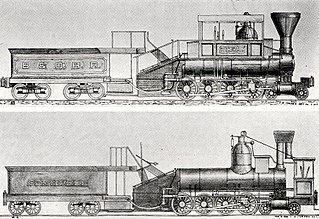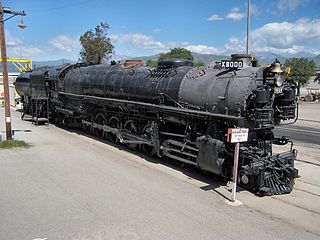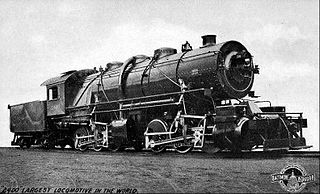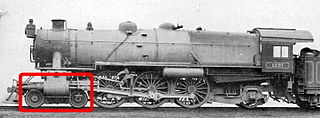
The Whyte notation is a classification method for steam locomotives, and some internal combustion locomotives and electric locomotives, by wheel arrangement. It was devised by Frederick Methvan Whyte, and came into use in the early twentieth century following a December 1900 editorial in American Engineer and Railroad Journal.

Under the Whyte notation for the classification of steam locomotives, a 2-10-4 locomotive has two leading wheels on one axle, usually in a bissel truck, ten coupled driving wheels on five axles, and four trailing wheels on two axles, usually in a bogie. These were referred to as the Texas type in most of the United States, the Colorado type on the Burlington Route and the Selkirk type in Canada.

A 2-8-8-4 steam locomotive, under the Whyte notation, has two leading wheels, two sets of eight driving wheels, and a four-wheel trailing truck. The type was generally named the Yellowstone, a name given it by the first owner, the Northern Pacific Railway, whose lines run near Yellowstone National Park. Seventy-two Yellowstone-type locomotives were built for four U.S. railroads.

A 4-8-8-4 in the Whyte notation for the classification of steam locomotives by wheel arrangement, is a locomotive with a four-wheel leading truck, two sets of eight driving wheels, and a four-wheel trailing truck. Only a single model of locomotive has ever used this configuration, which is commonly known as "Union Pacific Big Boys" after the railroad which operated them.

Under the Whyte notation for the classification of steam locomotives, 0-4-0 represents one of the simplest possible types, that with two axles and four coupled wheels, all of which are driven. The wheels on the earliest four-coupled locomotives were connected by a single gear wheel, but from 1825 the wheels were usually connected with coupling rods to form a single driven set.
The UIC classification of locomotive axle arrangements, sometimes known as German classification or German system, describes the wheel arrangement of locomotives, multiple units and trams. It is set out in the International Union of Railways (UIC) "Leaflet 650 – Standard designation of axle arrangement on locomotives and multiple-unit sets". It is used in much of the world. The United Kingdom uses the Whyte notation. The United States uses the simplified AAR wheel arrangement for modern locomotives.

Under the Whyte notation for the classification of steam locomotives, 4-8-0 represents the wheel arrangement of four leading wheels on two axles, usually in a leading truck or bogie, eight powered and coupled driving wheels on four axles and no trailing wheels. In North America and in some other countries the type was usually known as the Twelve-wheeler.

Under the Whyte notation for the classification of steam locomotives, 4-4-4 represents the wheel arrangement of four leading wheels on two axles, four powered and coupled driving wheels on two axles, and four trailing wheels on two axles. In the United States, this arrangement was named the Reading type, since the Philadelphia and Reading Railroad was the first to use it. In Canada, this type is known as the Jubilee.

Under the Whyte notation for the classification of steam locomotives by wheel arrangement, 6-8-6 represents the arrangement of six unpowered leading wheels arranged into a three-axle leading truck, eight powered driving wheels, and six unpowered trailing wheels arranged into a three-axle trailing truck.

Under the Whyte notation for the classification of steam locomotives, a 4-8-8-2 is a locomotive with four leading wheels, two sets of eight driving wheels, and a two-wheel trailing truck.

Under the Whyte notation for the classification of steam locomotives, 4-12-2 represents the wheel arrangement of four leading wheels, twelve coupled driving wheels, and two trailing wheels. This arrangement was named the Union Pacific type, after the only railroad to use it, the Union Pacific Railroad.
Under the Whyte notation for the classification of steam locomotives, 0-8-2 represents the wheel arrangement of no leading wheels, eight powered and coupled driving wheels on four axles, and two trailing wheels on one axle.
Under the Whyte notation for the classification of steam locomotives, 2-12-2 represents the wheel arrangement of two leading wheels on one axle, twelve powered and coupled driving wheels on six axles, and two trailing wheels on one axle.

Under the Whyte notation for the classification of steam locomotives, a 0-6-6-0 wheel arrangement refers to a locomotive with two engine units mounted under a rigid locomotive frame, with the front engine unit pivoting and each engine unit with six coupled driving wheels without any leading or trailing wheels. The wheel arrangement was mostly used to describe Mallet locomotive types.
Under the Whyte notation for the classification of steam locomotives, a 4-8-6 locomotive would have had four leading wheels, eight coupled driving wheels and six trailing wheels.

El Gobernador was a 4-10-0 steam locomotive built by Central Pacific Railroad at the railroad's Sacramento, California shops. It was the last of Central Pacific's locomotives to receive an official name and was also the only locomotive of this wheel arrangement to operate on United States rails. At the time it was built, El Gobernador was the largest railroad locomotive in the world. Its name is reminiscent of the railroad's first locomotive, Gov. Stanford, as El Gobernador is Spanish for The Governor. This locomotive is a Mastodon type. Confusingly, this was the unofficial name for an earlier engine, "Mastodon" No. 229, the first successful 4-8-0 ever built. Both engines looked nearly identical, except that El Gobernador was longer and had an additional pair of drivers.
In Whyte notation, a 4-6-6-2 is a steam locomotive with four leading wheels in an unpowered bogie at the front of the locomotive followed by two sets of driving wheels with six wheels each, followed by two unpowered trailing wheels at the rear of the locomotive.
In the Whyte notation for describing steam locomotive wheel arrangement, a 2-8-6 is a locomotive with a two-wheel leading truck, eight driving wheels, and a six-wheel trailing truck. All 2-8-6 locomotives constructed have been 2-8-6T tank locomotives of the Mason Bogie pattern.

Under the Whyte notation for the classification of steam locomotives by wheel arrangement, the 4-8-0+0-8-4 is a Garratt articulated locomotive. The wheel arrangement is effectively two 4-8-0 locomotives operating back to back, with the boiler and cab suspended between the two engine units. Each engine unit has two pairs of leading wheels in a leading bogie, followed by four coupled pairs of driving wheels and no trailing wheels. Since the 4-8-0 type is known as a Mastodon type, the corresponding Garratt type would be referred to as a Double Mastodon. A similar wheel arrangement exists for Mallet locomotives, but is referred to as 4-8-8-4.

The leading wheel or leading axle or pilot wheel of a steam locomotive is an unpowered wheel or axle located in front of the driving wheels. The axle or axles of the leading wheels are normally located on a leading truck. Leading wheels are used to help the locomotive negotiate curves and to support the front portion of the boiler.














